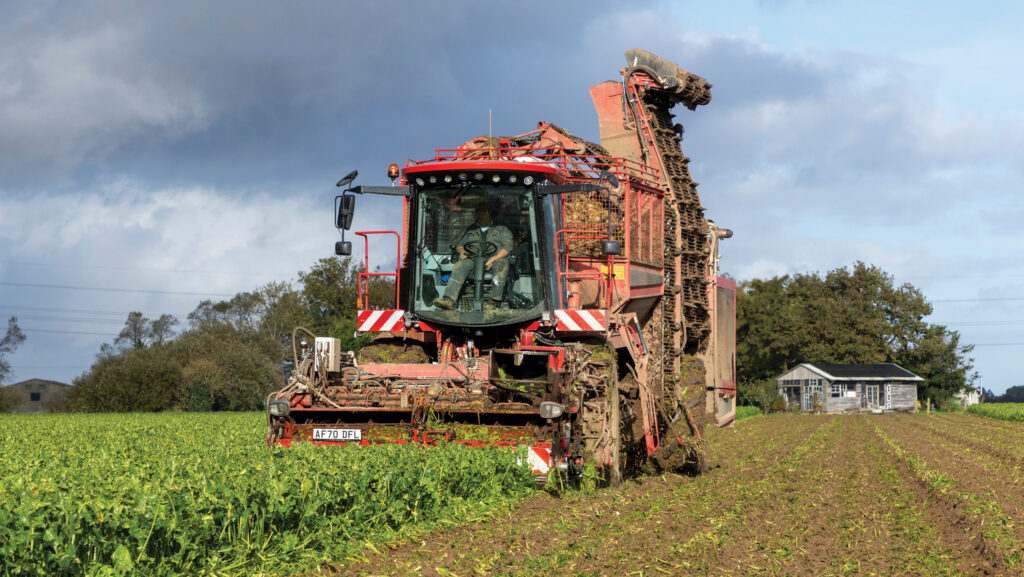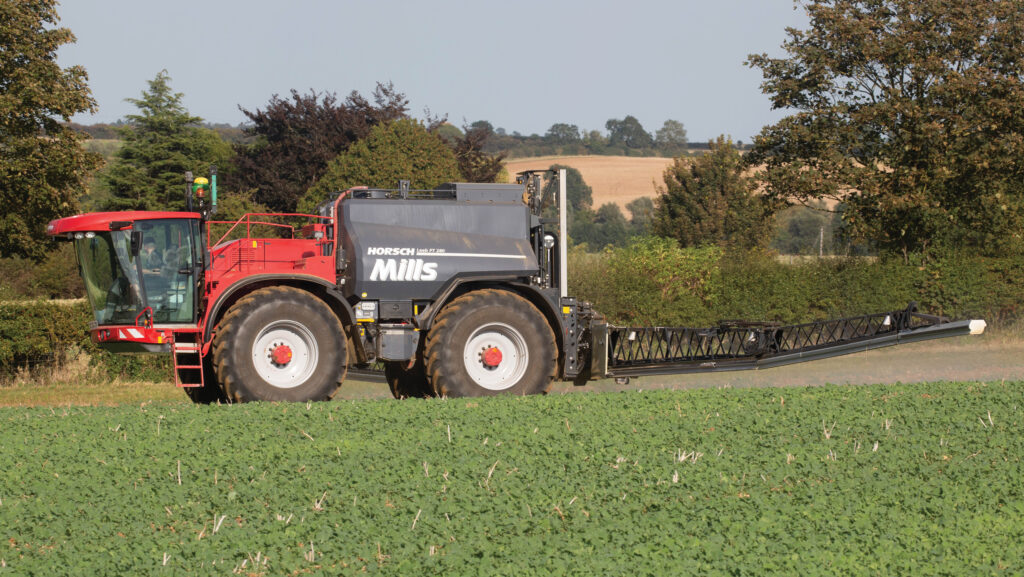Crop Watch: Stop-start wheat drilling and variable beet yields
 © GNP
© GNP Rain continues to blight the wheat drilling season with farmers grabbing the few opportunities as they arise.
The wet weather has also affected sugar beet lifting in the east, slowing down progress. Initial reports suggest that while yields are variable, sugar contents are good.
See also: 5 tips for achieving successful residual herbicides sprays
South
Oliver Pilbeam – CCC and CLM (Kent and Sussex)
After more than 200mm of rain in September, drilling finally got under way for many farmers a week or 10 days later than they would have liked.
While the wait was frustrating, a big positive has been good levels of blackgrass and ryegrass emergence predrilling. These fields received a minimum of 1,000g/ha of glyphostate 24-36 hours before planting.
It’s been a more straightforward year for ag chem supply, providing more flexibility designing a pre-emergence programme based on the weather and allowing aclonifen ordering to be left until a likely spray window becomes clearer (being a pre-emergence only product).
There is benefit in shopping around, particularly when ordering over-complicated box sets, twin packs or “virtual twin packs”, which often force you to purchase chemistry you don’t require.
Splitting box packs allows you to tailor your programme to the field’s requirements and can provide a cost saving of about £20-£25/ha, particularly if the box partner product can be used on another crop.
Remember, however, a mixture of active ingredients in the programme is best for a resistance management strategy.
Slug damage
Slug pressure has been high, particularly on second wheats or wheat following OSR. While pellet supply at the start of the season was good, it could “creak” if October finishes as it started.
The wet prevented much ground being rolled which will increase slug pressure. Monitoring crop emergence and slug grazing will be a priority, as will keeping a close eye on blackgrass emergence.
Many of my blackgrass programmes are based around cinmethylin and will be topped up with flufenacet applications at peri- or post-emergence, when and if conditions allows. Where applicable, this is likely to tie in with an insecticide for aphid control to reduce barley yellow dwarf virus (BYDV) damage – which we’re seeing more of on the south coast.
OSR drilled after mid-September looks good, but cabbage stem flea beetle (CSFB) has taken its toll on crops drilled before then. Difficult decisions will have to be taken on which crops will make it and if it will be worth investing in a propyzamide application when soil temperatures are suitable.
The fallback position will be increasing areas of peas or beans or SFI actions. With my time spilt between agronomy, consultancy and managing the family farm, I’m very aware of the ever-increasing amount of working capital required – so the known quarterly payment dates and amounts that SFI provides has a real value.
North
Patrick Stephenson – AICC (Yorkshire)
Looking back over previous Cropwatch articles it is impossible to eliminate the impact weather has on the content. I would have to say this year we have certainly had the four-leaf clover! The worst of the weather has missed us and drilling-wise we are nearly complete.
Don’t get me wrong, we have had disruptive rain, but nothing compared with the Midlands. In overall terms I will have lost approximately 10-15% of my farmed area to various Sustainable Farming Incentive options. This varies from 100% on some farms to 0% on others.
Sadly, I fear that some of the fallow options and wild bird covers will generate huge problems as we try to manage the weed burden it looks as if they will create. I will not dwell on that anymore, but concentrate on what we have done.
The pre-emergence herbicides have been a mixed bag in the case of application. The scramble to take drilling opportunities has often meant that they have been missed.
In wheat crops where the pre-emergence has been missed, we still have a range of options that can give us reasonable levels of control at peri-and early post-emergence. In winter barley the options are much less and will cause me a headache.
Pre-emergence top-ups
The growers who managed to get pre-emergence sprays on will now be topping up the programmes.
Like much of the UK, we now have the full range of invasive grassweeds, bromes (all species) ryegrass, blackgrass, wild oats, and rat-tailed fescue.
This is where the finesse of the top-up spray is required as we try to cover extended germination periods and the major threat.
The early drilled crops have benefited from good, rapid emergence, managing to beat the armada of slugs waiting for the smorgasbord we had delivered.
Unfortunately, I think the boot will be firmly on the other foot now as soils cool and good seed-beds are no longer order of the day.
I find myself dreaming of products we once had that worked well, such as methiocarb for slug control.
It is amazing how I don’t remember the collateral damage it caused in the countryside when consumed by the non-target creatures!
I am still waiting for some renowned entomologist to explain to me what has happened with the cabbage stem flea beetle this year? I reckon if I had drilled both carriageways of the A1 it would have grown.
My area of rape peaked around 2012 accounting for just short of 20% of my area as of today it is a mere 7%.
The July OSR crops are now huge, and some will have received an application of growth regulator.
At present, phoma is confined to the high erucic acid rapeseed varieties which will justify a fungicide intervention. The conventional varieties I will leave as a waiting brief.
The lack of faith in growing OSR has meant that many did not receive a pre-emergence herbicide.
I will not wait for my Corteva Christmas card to tell me “It is now cold enough to apply propyzamide”, but have already left sheets for the use of Astrokerb (aminopyralid + propyzamide) or Belkar (halauxifen + picloram) plus propyzamide options.
I appreciate that temperatures are still warm, but weeds are still growing and our weather windows close in rapidly now.
Winter beans are now being drilled and the application of propyzamide and the wonderfully named Stallion Syn Tec (clomazone + pendimethalin) are being applied.
I hope my colleagues in the Midlands do get a break from the relentless weather and are able to get some drilling done.
East
Rory Kissock – Farmacy (Essex, Herts, Cambs and Suffolk)
Hello, my name is Rory Kissock and I am an agronomist working for Farmacy based in Essex covering the surrounding counties of Hertfordshire, Cambridgeshire and Suffolk borders.
Wheat drilling is very much a stop/start affair within the region as the weather continues to slow progress.
Useful rains at the end of September have allowed for sufficient grassweed germination which will receive an application of glyphosate pre-drilling.
Pre-emergence herbicides vary depending on target grassweeds and the pressure each field is under.
Cinmethylin, flufenacet, diflufenican and tri-allate can form the base of pre-emergence stacks, with the addition of pendimethalin, metribuzin, prosulfocarb and alconifen where required.
Resistance testing is a good way of understanding the weed populations you are dealing with to ensure you are getting best value for money from herbicides.
Most winter barley crops have been drilled into good seed-beds and have received a pre-emergence herbicide.
On-going monitoring of these crops as they emerge is important when it comes to slug management, in general slug populations are high and traps should be placed out in fields and if thresholds are met then pelleting would be advised.
Aphid threat
Barley yellow dwarf virus (BYDV) risk will start as these crops emerge.
Crop monitoring for aphids (bird cherry oat and grain aphid) alongside online tools which can be used to record the T-Sum 170 calculation will aid an IPM approach to insecticide applications.
The sugar beet campaign has started and so far, yields seem to be variable, but with good sugar content.
Persistent rains have slowed the progress of sugar beet being lifted. Growers are keen to lift, cultivate and drill subsequent crops without exposing cultivated land to too much rain.
Recent focus has been on the 2025 campaign around seed selection, price and insurances on offer from British Sugar that might be utilised.
Oilseed rape crops are continuing to move, early-drilled crops have established well despite the lack of rain post-drilling when they needed it.
The later drilled crops have benefited from the recent rains and the plant populations are good across the board, but the dreaded bank holiday cabbage stem flea beetle (CSFB) invasions have hindered them more.
Some crops have received treatments of lambda-cyhalothrin for CSFB and a graminicide for volunteer cereals.
West
Antony Wade – Hillhampton Technical Services (Hereford/Shropshire)

© Tim Scrivener
Farmers and agronomists were united in wanting to see the back of the 2024 season, get fields harvested and start afresh for the 2025 season.
Harvest dragged on with an increased acreage of spring crops extending it into early September.
So some farms were trying to manage finishing harvest, drill oilseed rape and grass seeds – not a gentle start to the autumn workload.
There was a consensus after last autumn that they were going to get drilling as soon as they could in mid-September as surely it couldn’t be that wet!
So, some did start drilling cereals in ideal seed-bed conditions, only to have a deluge starting on 20 September, about three weeks earlier than autumn 2023.
Fortunately, these have emerged OK. Despite the rain soon after drilling, pre-emergence herbicides seem to be still active on emerging weeds.
My area didn’t suffer as badly as others, but still three times average September rainfall was not the start we had hoped for in autumn 2024.
Not late
I had to reassure quite a few clients that we were not late and there is still time, as it is only October.
In the past couple of weeks following two spells of two-to-three dry days has allowed some drilling of cereals in many cases (sorry not on trend) using the tried-and-tested method of plough and planting as the only way to get something in the ground.
It seems our weather patterns require farmers not only to be resilient, but also adaptable.
The “old ways” are not always the “wrong way”. But I fear for the many quagmires left in fields following potatoes and maize.
There is just no way to get a crop established this side of spring. Not sure the “rent cheque” is going to cover the two-to-four years of soil damage to following crops.
Following abysmal oilseed rape yields for my region and the gamble that growing the crop presents, a number of my clients dropped OSR from their rotation either for an SFI option, or for some, turning back to beans either winter or spring.
Typically, as Sod’s Law dictates, we have seen less CSFB pressure than the past two-to-three seasons, so most crops have got away well and will have had a graminicide by the time of printing.
I will be looking to get some broad-leaved herbicide on before the end of October.

